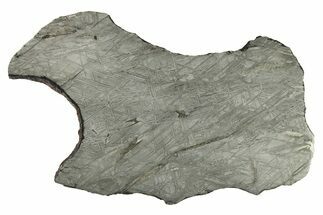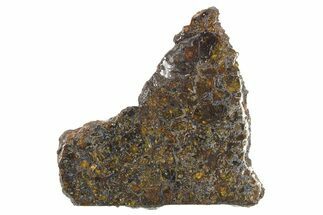This Specimen has been sold.
1.8" Etched Seymchan Pallasite Slice (22 g) - Russia
This is a 1.8" wide (22 grams) piece of the Seymchan pallasite meteorite from the Magadan district of Russia. It has been nicely cut/etched into a thin slice to display the complex Widmanstätten pattern.
The Seymchan Meteorite
The Seymchan meteorite is a PMG (main group) pallasite, found in the dry riverbed of the Hekandue River, near the city of Seymchan in eastern Russia. The main 270-kilogram mass was discovered in 1967, and was originally classified as a coarse octahedrite (IIE) iron.
Another 50 kilograms were recovered in 2004, containing olivine crystals in about 20 percent of the new material. Seymchan was appropriately reclassified as a PMG pallasite. Theories suggest these olivine-rich portions were sheared off of the main metallic body at their border points.
This meteorite has a few unique features: it contains an unusually high amount of iridium, which may make cases for mining asteroids for the element. Its Widmanstätten patterns are also bent due to massive shearing forces at impact.
The Seymchan meteorite is a PMG (main group) pallasite, found in the dry riverbed of the Hekandue River, near the city of Seymchan in eastern Russia. The main 270-kilogram mass was discovered in 1967, and was originally classified as a coarse octahedrite (IIE) iron.
Another 50 kilograms were recovered in 2004, containing olivine crystals in about 20 percent of the new material. Seymchan was appropriately reclassified as a PMG pallasite. Theories suggest these olivine-rich portions were sheared off of the main metallic body at their border points.
This meteorite has a few unique features: it contains an unusually high amount of iridium, which may make cases for mining asteroids for the element. Its Widmanstätten patterns are also bent due to massive shearing forces at impact.
About Pallasites
Pallasite meteorites are a class of stony-iron meteorites. They were once believed to have originated at the core-mantle boundary of asteroids that shattered through impacts, but a recent hypothesis is that they are a mixture of core and mantle minerals.
Pallasite meteorites consist of olivine (peridot) crystals surrounded by iron-nickel matrix. Upon acid etching, some pallasites display interweaving structures known as Widmanstätten patterns (or Thomson lines) in the metallic matrix. These structures are iron-nickel alloy crystals, typically kamacite and taenite, that cooled over millions of years in the vacuum of space.
Pallasites are quite rare: only about 200 are known, and only four have had observed falls. This represents less than 0.2% of all classified meteorites!
Pallasite Care
Pallasites are even more susceptible than most iron meteorites to rusting and deterioration due to moisture in the atmosphere; proper care includes keeping them in moisture-free environments. This is particularly important in areas with high humidity, such as Florida. All pallasite material we sell has been stabilized in some way, which will help with this issue, but care still needs to be taken to keep your treasure in good condition. Keep pallasites stored in a moisture-free environment, preferably with a corrosion inhibitor such as silica gel beads or a dehumidifier.
Pallasite meteorites are a class of stony-iron meteorites. They were once believed to have originated at the core-mantle boundary of asteroids that shattered through impacts, but a recent hypothesis is that they are a mixture of core and mantle minerals.
Pallasite meteorites consist of olivine (peridot) crystals surrounded by iron-nickel matrix. Upon acid etching, some pallasites display interweaving structures known as Widmanstätten patterns (or Thomson lines) in the metallic matrix. These structures are iron-nickel alloy crystals, typically kamacite and taenite, that cooled over millions of years in the vacuum of space.
Pallasites are quite rare: only about 200 are known, and only four have had observed falls. This represents less than 0.2% of all classified meteorites!
Pallasite Care
Pallasites are even more susceptible than most iron meteorites to rusting and deterioration due to moisture in the atmosphere; proper care includes keeping them in moisture-free environments. This is particularly important in areas with high humidity, such as Florida. All pallasite material we sell has been stabilized in some way, which will help with this issue, but care still needs to be taken to keep your treasure in good condition. Keep pallasites stored in a moisture-free environment, preferably with a corrosion inhibitor such as silica gel beads or a dehumidifier.
SPECIES
Pallasite (PMG)
LOCATION
Magadan District, Russia
SIZE
1.8 x 1.1", .1" thick, Weight: 22 grams
CATEGORY
SUB CATEGORY
ITEM
#243068
 Reviews
Reviews












